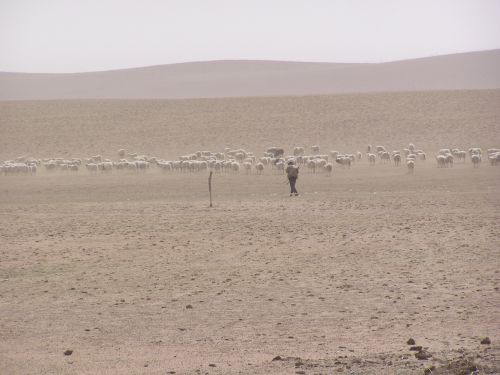While Sydneysiders, Canberrans and other urbanites were going “Wow! Cool! It must be like Mars!” as the recent dust storm enveloped them in its eerie extraterrestrial glow, few seem to have paused to reflect that they are - at least in part, if not completely - to blame for the phenomenon.
Next time you hop into the supermarket for a loaf of bread or a juicy steak, you need to consider the damage you are doing to the continent, the planet and your children’s prospects on it, with your tiny economic signal.
Australia, say the scientists, is in a “dust age” - a period of accelerated erosion brought about, mainly by two things: the ten-year drought, which has dried things out incredibly, and the pressure which all farmers the world over are being forced to put on the landscape thanks to the rotten prices they get paid in the globalised food system. These compel many of them to take unwise decisions to overstock or overcrop, and when the drought comes, the country blows.
Advertisement
In all of human history, food has never been so cheap. The average Australian spends about half what their parents and grandparents did, in terms of disposable income, on food. That’s how we can afford all those 4WDs, plasmas and electronic trinkets.
The miracle has been achieved by farmers and scientists dramatically intensifying farming systems, raising farm productivity - and so reducing what it “costs” to produce food. And by great big food corporations and supermarkets who play one country’s farmers off against another in their efforts to extract the lowest possible price. Just to please you.
What most people don’t seem to get is that there is a real cost to this that every one of us is bound to pay sooner or later. It is coming out of the environment and at this stage there seems little chance of stopping it.
Think about cities. If you added together all the world’s cities and towns you’d cover an area of soil half the size of China or the USA with concrete and asphalt. At current rates of growth, the footprint of the “world city” will be larger than either the US or China by 2040. Since cities are, for the most part, located (for historical reasons) in fertile river valleys, it follows they permanently eliminate some of the world’s richest soils. The effect of their expansion is to force agriculture farther and farther out into drier, more marginal, drought and erosion-prone country. In effect, one hectare of lost river valley land has to be replaced by four or five hectares of dryland to grow the same amount of food. This then has to be trucked hundreds or even thousands of kilometres.
In 1990 a world study called GLASOD found 15 per cent of the world’s useable land area to be seriously degraded. In Asia, Africa and South America soil losses were 30-40 times greater than the rate at which soil naturally forms. Slopes and badly-degraded rangelands, were losing up to 100 tonnes of soil per hectare every year. In 2008 a world satellite survey found the degraded area had risen to 24 per cent - and it mostly appeared to be in new areas, additional to the old, clapped-out lands.
Current rates of soil loss are estimated at about 1 per cent a year, which doesn’t sound much, but add 1 per cent a year to 24 per cent, and then see how much food-producing land is left in 2050 to meet human demand for a doubling in the world’s food supply.
Advertisement

To illustrate, the picture above, taken by Charles Sturt University’s Professor of Farming Systems David Kemp, shows a Mongolian “grassland”. A generation ago the graziers were complaining they couldn’t find their cattle because the grass was too high. Now, they say, they can see the mice. This is happening in dry lands around the world as farmers desperately try to scrape a living amid falling returns by running more stock or planting more crops. The price signal to do this goes straight from the affluent consumer, often completely oblivious of where their food comes from or how agricultural markets work, to the world’s 1.8 billion farmers.
The money you have saved on food in the last 40 years is being subtracted from the world’s dwindling farm lands in the form of soil, carbon, nutrients and future food.
When you leave the supermarket with bulging bags and gun up the urban 4WD, the scientific evidence suggests, you are also helping to ensure less rain falls over these already ravaged regions. The scientists I speak to say there is a clear link between human CO2 emissions and large-scale weather patterns like El Niño, the Indian Ocean Dipole and the Southern Ocean Annular Mode, which all bring drought to southern and eastern Australia. The more carbon we release, the drier the world’s grasslands and grainbelts are going to get.
Now I’m not trying to make anyone feel bad here. After all, you maybe didn’t realise the full impact of your choices about tonight’s meal. But I am saying that the extent of the problem is now so large, globally, that there are no “quick fixes” other than for humanity to moderate its diet. And for supermarkets to stop screwing farmers.
And for that to happen, alas, your economic signal has to change and you will probably end up paying much the same for food, in real terms, as your Nan and Gramps used to. They, after all, had a food system that was fairly sustainable. If we aren’t willing to make this little sacrifice, then we needn’t even bother to try to settle Mars. For all intents and purposes, Mars will come to us.